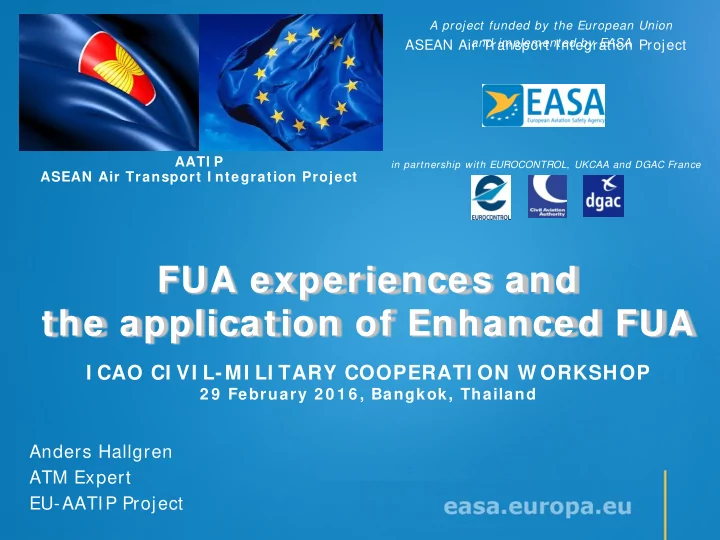

A project funded by the European Union and implemented by EASA ASEAN Air Transport Integration Project AATI P in partnership with EUROCONTROL, UKCAA and DGAC France ASEAN Air Transport I ntegration Project FUA experiences and the application of Enhanced FUA I CAO CI VI L-MI LI TARY COOPERATI ON W ORKSHOP 2 9 February 2 0 1 6 , Bangkok, Thailand Anders Hallgren ATM Expert EU-AATIP Project
Ensuring a 'Flexible Use of Airspace'… . Presentation structure: How FUA is applied in Europe Benefits of FUA Dynamic Management of Airspace 2
Overview of Europe’s Traffic Dense Route Network 1000 airports 30000 aircraft per day 1000 control sectors 80% of traffic is European internal 50% of traffic flies less than 600km Military requirements 3
Flight per day More than 160 A/C 80 to 160 A/C 40 to 80 A/C 20 to 40 A/C 2 to 20 A/C
5
ATM System I m provem ents Strategy Strategic Planning of 1 . Airspace Route netw ork Developm ent National Re-Sectorisation Controller W orkload 2 . I ncreased Capacity ATC procedures Reduced Delays System Support I m proved Flight Profiles 3 . Better Use and Managem ent of Airspace RVSM Perf Based Navigation Flexible Use of Airspace 6
How to satisfy all the stakeholders’ requirements ? Since 1 9 9 6 through … FLEXIBLE USE OF AIRSPACE CONCEPT 7
The basis of the FUA concept • Airspace no longer designated as civil or military airspace , a continuum • Airspace used flexibly on a day to day basis necessary airspace segregation only of temporary nature ; • Ensure more efficient sharing through joint civil/military strategic planning and pre-tactical airspace allocation: Airspace Management Cells (AMCs) 8
Fundam ental principle of FUA Airspace should not be designated as either pure civil or military airspace, but rather be considered as a continuum in which all user requirements have to be accommodated to the extent possible. 9
Non-FUA vs. FUA = P P PROHIBITED PROHIBITED CROSSING POSSIBLE TEMPORARY = TRA TRA D WHEN ACTIVE / RELEASED RESERVED AREA DANGER AS SOON AS ACTIVITY STOPS TEMPORARY = R TSA TSA RELEASED AS SOON AS RESTRICTED SEGREGATED ACTIVITY STOPS AREA 10
Through Civil / Military Coordination … ASM Level 1 Strategic Level High-Level Civil / Military Definition and review of national airspace Airspace Policy policy and organisation, establishment of pre- Body determined airspace structures ASM Level 2 Pre-tactical Level Joint Civil / Military Day-to day airspace allocation according Cell (AMC) to user requirements Tactical Level ASM Level 3 Appropriate Real-time use of airspace allowing a safe Civil / Military separation between civil and military ATS Units aircraft 11
CDR Categorisation Expected to be available most of the time Permanently plannable during the Plannable same way as permanent ATS CDR 1 times published in AIP routes Daily allocated as negotiated Plannable only in accordance with daily CDR 2 Non-permanently plannable AUP/EAUP Part of pre-defined routing scenario Usable upon ATC instructions only as short Not Plannable CDR 3 notice routing 12
ASM Notification Process Mil airspace users advise on requirement; National Airspace Use Plan (AUP); Put together by the Network Manager, becomes European Airspace Use Plan (EAUP); Used by Aircraft Operators in improving flight trajectory. 13
Regulatory aspect in regard to FUA Concept Compilation of existing (best) practices SES Regulatory EUROCONTROL Framework FUA Reference FUA Material SPECIFICATION FUA REGULATION Existing FUA Provisions FUA Specification seen as an interface
FUA Specifications • provides details of procedures and requirements for the application of FUA • addresses essential interoperability requirements • a means of compliance
ASM Handbook • FUA Concept described • Processes & procedures at all three ASM Levels • It is the reference document for FUA Regulation EUROCONTROL FUA Guidance Documents
Benefits 340.000 tons CO2/year 108.000 tons fuel/year 87 million Euro/year 17
Assessment of FUA Operations POTENTIAL ECONOMY NOT UTILISED 1 week day By not planning on available CDRs 10.321 NM on 2.784 flights Fuel : CO 2 Emissions : 129 T 407 T 105.780 € 18
ASM/ ATFCM Process Airspace not used optimally Impact on performance of Network The Problem After notification at 15.00 0n Day -1 – tactical Work load intense Opportunities not used 19
Tracks far from optimum LQSA-LOW W 5 1 NM - difference betw een flow n track and direct distance. No better airw ay links - published or available. ...and what is actually flown... (daily)
Enhanced ASM/ ATFCM Process Dynamic Static frozen Day-1 picture periodically updated Excessive Booking Accurate Booking AIM Difficult User Friendly Strategic processes on Day of Ops 21
I CAO Manual on ATFM 22
Improved CDR Network Improving airspace utilisation 23
System Support to Civ/ Mil ASM coordination ASM support system CI AM • System to support • airspace planning and allocation, • CIV – MIL coordination, ► Ensure the sharing of • common situational awareness, information among • collection of statistical ASM data Airspace Management users LARA - STANLEY Airspace Data Repository ► Enables users to keep up-to-date with airspace status data 25
Commitment AMCs/ NM (CFMU) CIV Mil ANSPs ANSPs ACTORS Mil Aircraft Airspace Operators Users 26
Enhanced ASM/ATFCM Process 27
A project funded by the European Union and implemented by EASA AATI P in partnership with EUROCONTROL, UKCAA and DGAC France ASEAN Air Transport I ntegration Project Thank you.
Recommend
More recommend